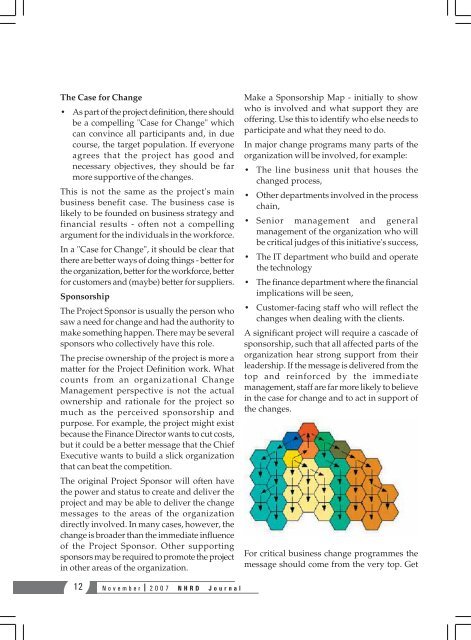NHRD Journal - National HRD Network
NHRD Journal - National HRD Network
NHRD Journal - National HRD Network
You also want an ePaper? Increase the reach of your titles
YUMPU automatically turns print PDFs into web optimized ePapers that Google loves.
The Case for Change<br />
• As part of the project definition, there should<br />
be a compelling "Case for Change" which<br />
can convince all participants and, in due<br />
course, the target population. If everyone<br />
agrees that the project has good and<br />
necessary objectives, they should be far<br />
more supportive of the changes.<br />
This is not the same as the project's main<br />
business benefit case. The business case is<br />
likely to be founded on business strategy and<br />
financial results - often not a compelling<br />
argument for the individuals in the workforce.<br />
In a "Case for Change", it should be clear that<br />
there are better ways of doing things - better for<br />
the organization, better for the workforce, better<br />
for customers and (maybe) better for suppliers.<br />
Sponsorship<br />
The Project Sponsor is usually the person who<br />
saw a need for change and had the authority to<br />
make something happen. There may be several<br />
sponsors who collectively have this role.<br />
The precise ownership of the project is more a<br />
matter for the Project Definition work. What<br />
counts from an organizational Change<br />
Management perspective is not the actual<br />
ownership and rationale for the project so<br />
much as the perceived sponsorship and<br />
purpose. For example, the project might exist<br />
because the Finance Director wants to cut costs,<br />
but it could be a better message that the Chief<br />
Executive wants to build a slick organization<br />
that can beat the competition.<br />
The original Project Sponsor will often have<br />
the power and status to create and deliver the<br />
project and may be able to deliver the change<br />
messages to the areas of the organization<br />
directly involved. In many cases, however, the<br />
change is broader than the immediate influence<br />
of the Project Sponsor. Other supporting<br />
sponsors may be required to promote the project<br />
in other areas of the organization.<br />
Make a Sponsorship Map - initially to show<br />
who is involved and what support they are<br />
offering. Use this to identify who else needs to<br />
participate and what they need to do.<br />
In major change programs many parts of the<br />
organization will be involved, for example:<br />
• The line business unit that houses the<br />
changed process,<br />
• Other departments involved in the process<br />
chain,<br />
• Senior management and general<br />
management of the organization who will<br />
be critical judges of this initiative's success,<br />
• The IT department who build and operate<br />
the technology<br />
• The finance department where the financial<br />
implications will be seen,<br />
• Customer-facing staff who will reflect the<br />
changes when dealing with the clients.<br />
A significant project will require a cascade of<br />
sponsorship, such that all affected parts of the<br />
organization hear strong support from their<br />
leadership. If the message is delivered from the<br />
top and reinforced by the immediate<br />
management, staff are far more likely to believe<br />
in the case for change and to act in support of<br />
the changes.<br />
For critical business change programmes the<br />
message should come from the very top. Get<br />
12<br />
November 2007 <strong>N<strong>HRD</strong></strong> <strong>Journal</strong>
















